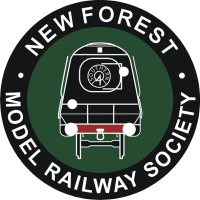
Layouts
The NFMRS is currently operating and constructing several layouts in N and OO gauge. Of course, the members have their own layouts that they exhibit from time to time. You may well have seen these at our May Exhibition or the Open Days that we have in November each year.
Layouts described here are:
- Mossbank Yard.A busy sidings layout in OO gauge.
- Knightwood Junction. A large OO layout.
- Milford on Sea. An imaginary terminus layout based on a local seaside town.
- Penny Lane. A novel OO micro layout with a Beatles theme.
- Albany. An N gauge layout based on Arley station on the Severn Valley Railway.
- Ipleigh Castle. A layout showing how a simple layout is fun.
- Freshwater. Recreating an Isle of Wight station.
- Watchumgobye A dual gauge continuous layout with complex controls.
- Future Layouts
Mossbank Yard
Mossbank Yard is a very large modern image club layout depicting BR Speedlink times around 1980 to 1995 and privately owned by a club member. In one section there are no less than nine parallel tracks on this busy railway. The layout measures 31ft x 2ft and with all this complexity DCC control is a must - six operators are required for a two day exhibition. Club members run just about every class of diesel and electric locomotives many of which are modified RTR (Ready to Run) by either weathering or respraying. Rolling stock is also either modified RTR or scratch built.
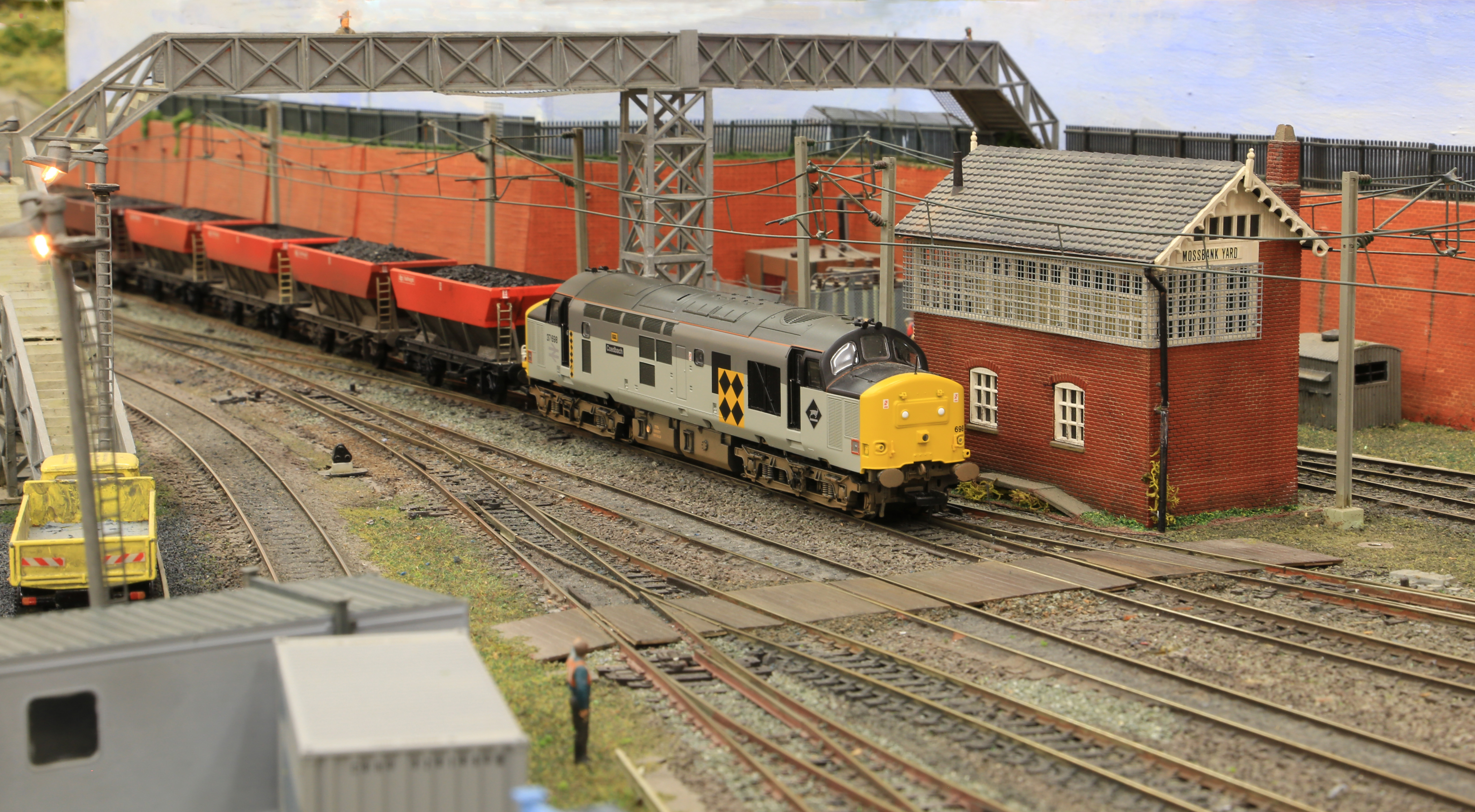
There are several local details to compliment the main railway: a canal basin with locks and long boats, a private chemical siding and a private distribution facility as well as the general cabins and infrastructure you would expect to see in this environment.
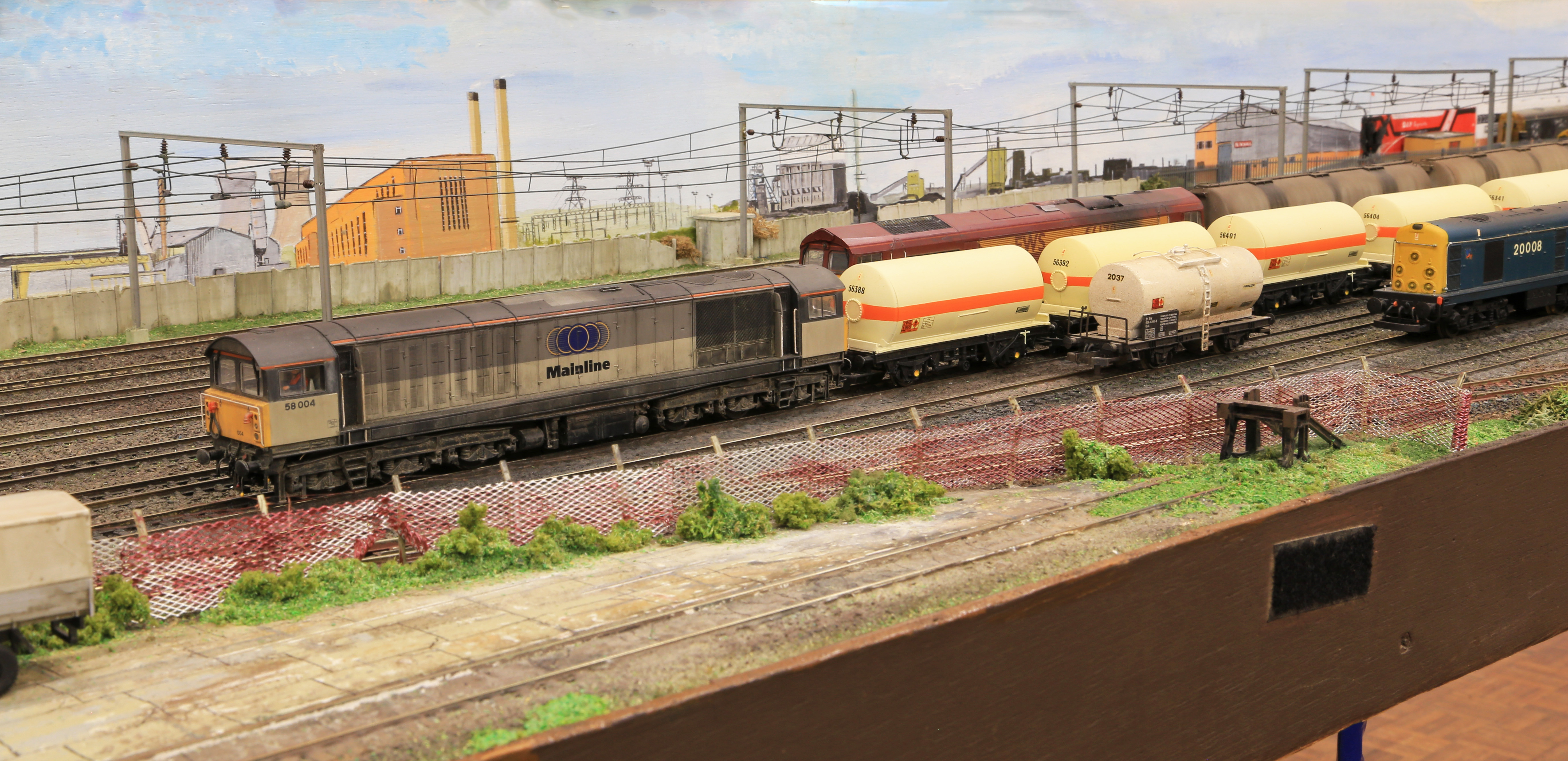
There is a predetermined operating system, for Mossbank Yard. All the stock used is known to have run in the area during the period modelled, and the operating sequence tries to adheres as closely as possible to the running of Speedlink and its successors. Freight traffic arrives at Mossbank from either North or South in the reception sidings, and is either re-marshalled in Mossbank Yard or held for loco or crew changes before recommencing its journey. Passenger services are handled by DMUs passing by on the through line, and even overhead wires are installed on both the through line and the reception sidings supplying power for AC electric classes. All movements are controlled by fully operational colour light signals by Roger Murray and backscenes are by Adrian Cox.
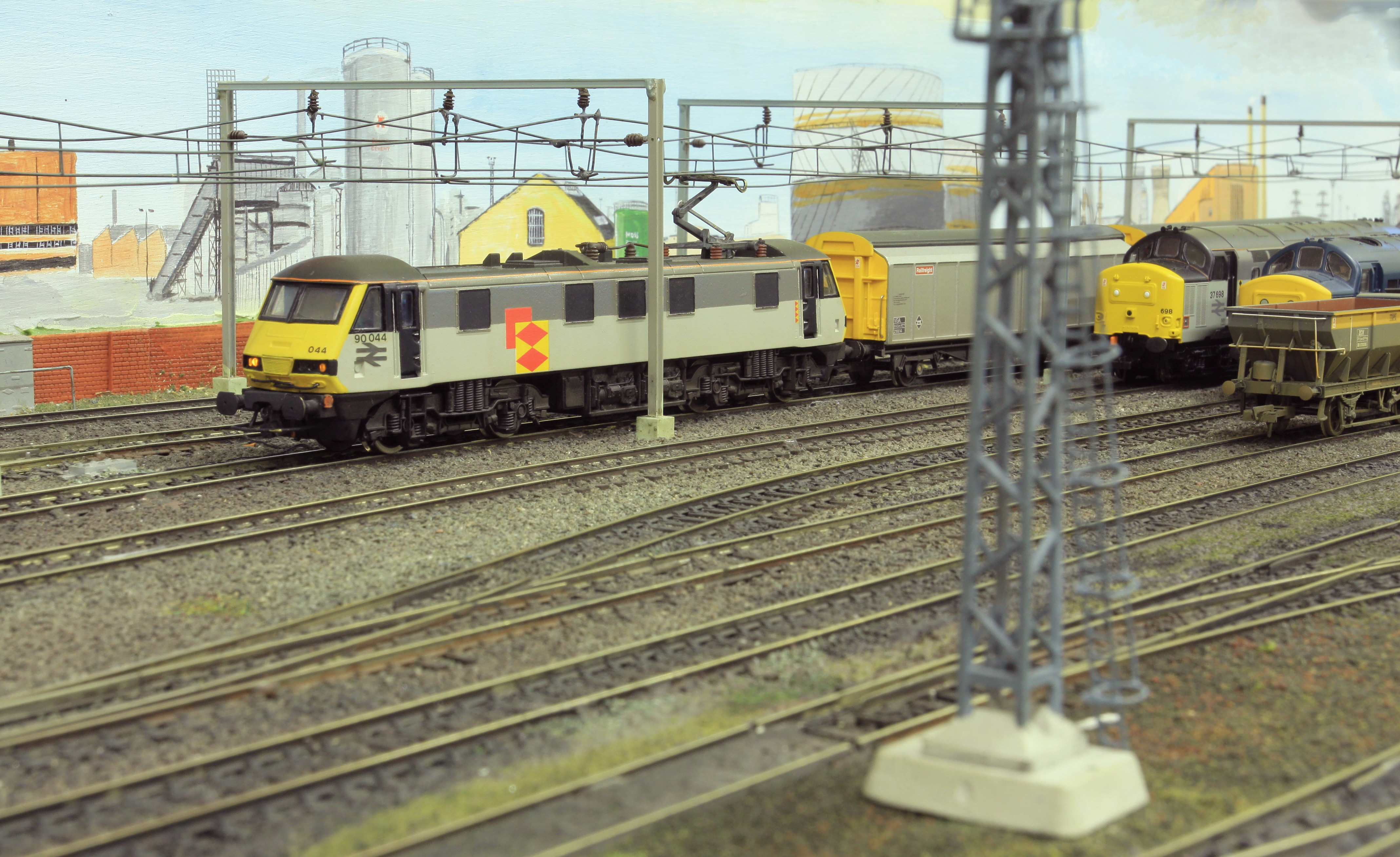
And if all that is not enough, for a grand scale Mossbank yard can be connected to other NFMRS club layouts Hollybank Depot and Westcliffe CCE (Chief Civil Engineers) Yard to present a super layout.
Knightwood Junction
When this layout was first built almost 40 years ago, it was to depict an imagined diversionary route on the West Coast Main Line in the steam era of the early to mid 20th century. The layout was fully signaled with upper-quadrant semaphore signals and gantries. At the time, the loyalties of the team of club members running the layout were to mainly with the LMS.
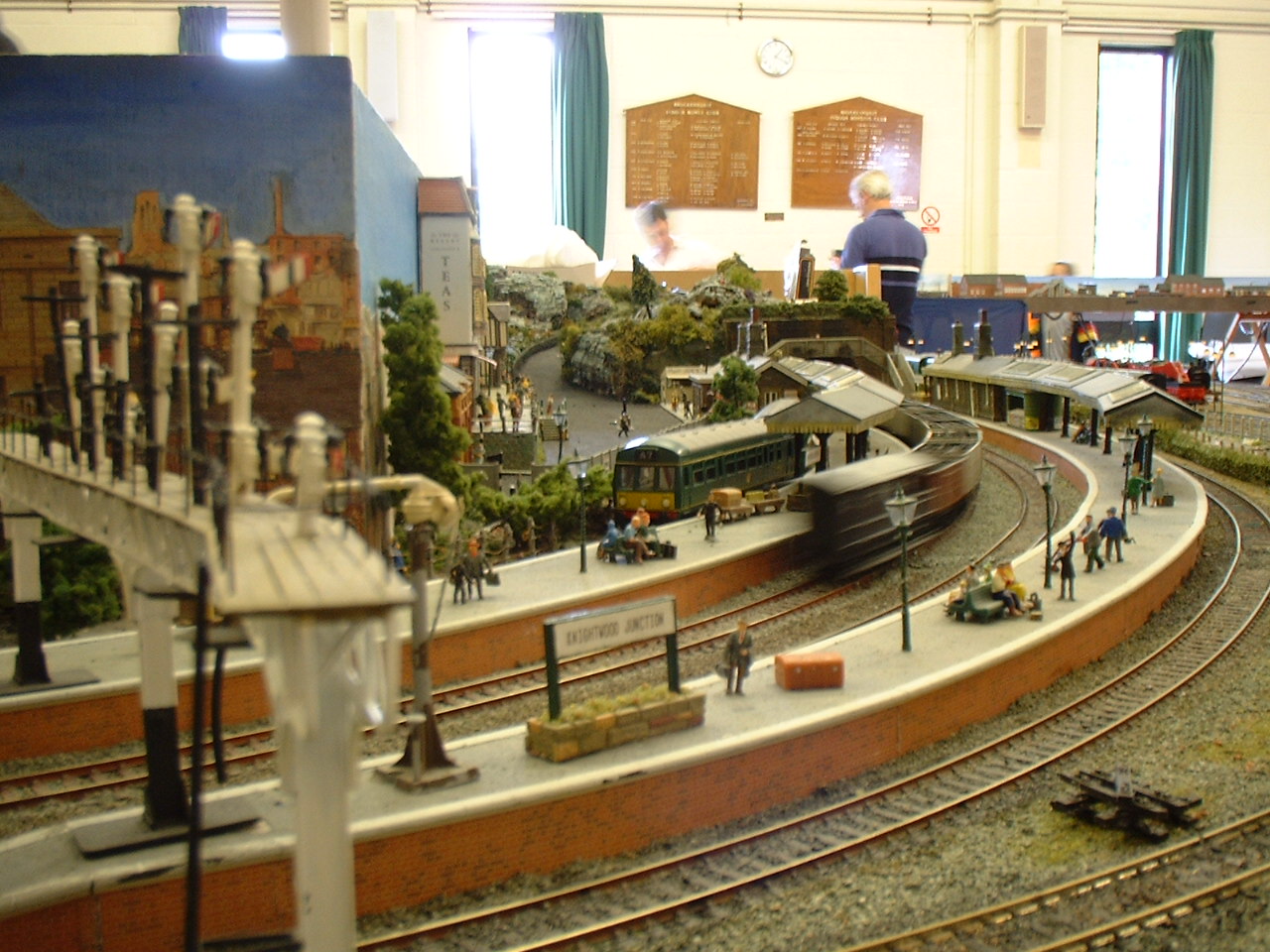
In the present day, the layout is still a depicting a diversionary route, but now moved into the latter part of the 20th century with a mixture of steam, diesel and some third-rail DC traction. Some of the semaphore signaling have been replaced by coloured light signals on the main line depicting the process of updating and modernisation of signaling systems.
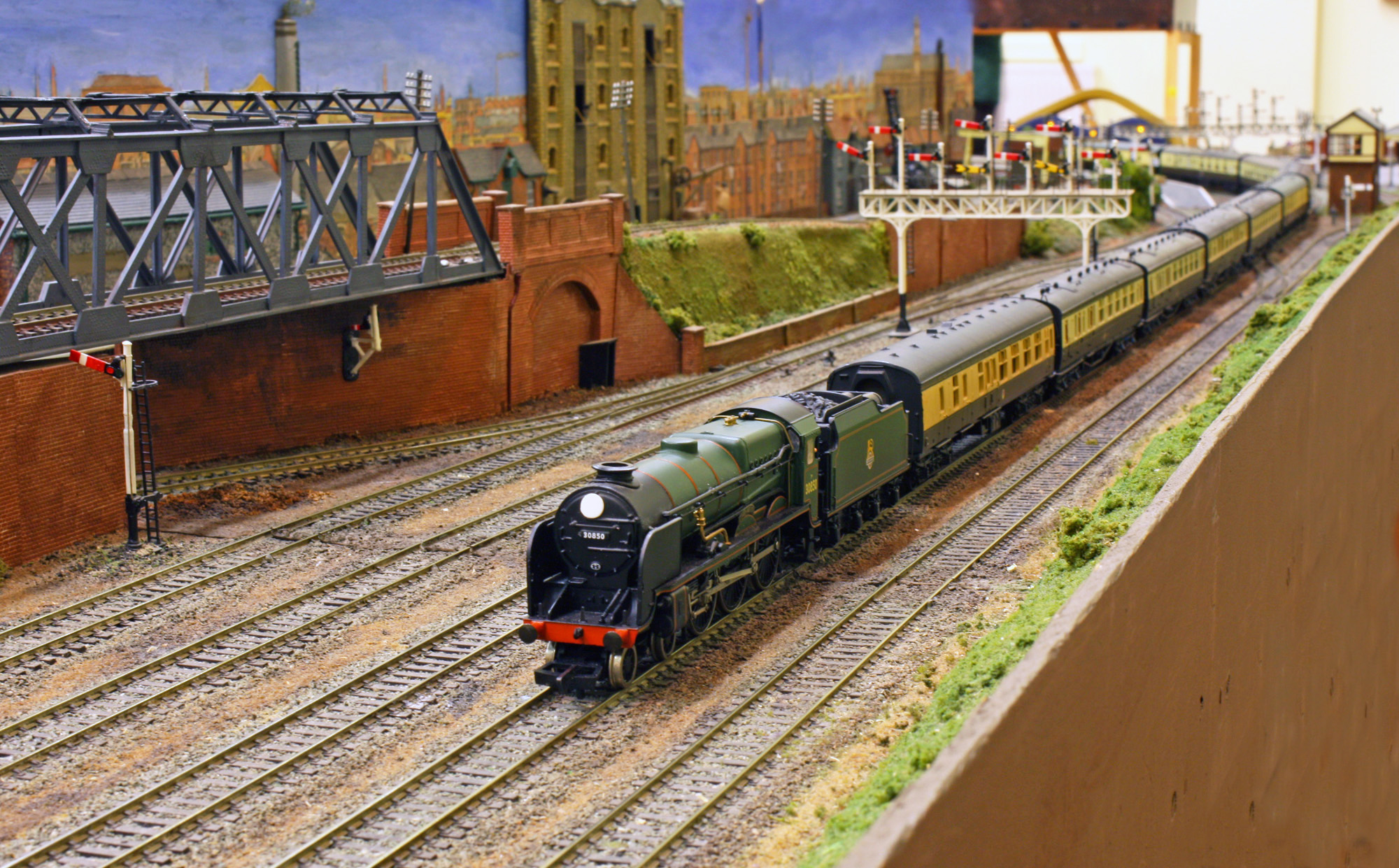
The current team of club members running Knightwood are much more diverse in their loyalties. LMS, GWR, LNER and Southern, all make appearances on club evening meetings, Sunday running days and exhibitions/open-days.

Knightwood now provides an ideal way for members to 'showcase' their own stock. It features models from the 'big four’ plus early British Railways, mostly RTR but also some modified and kit-built items dating from the 1960s up to the latest introductions
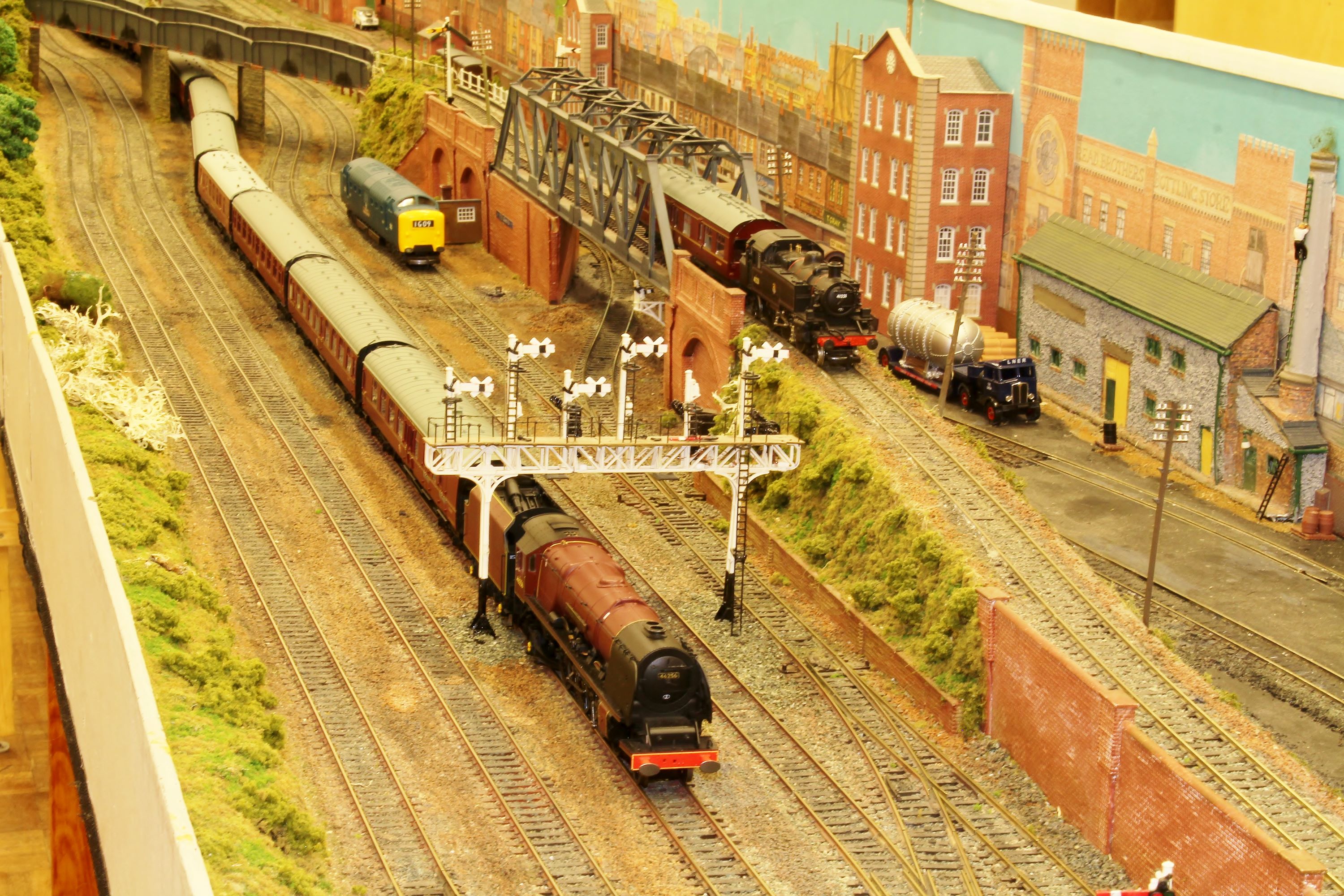
The Knightwood Junction layout is approximately 25 feet by 9 feet in size and comprises a full circuit of double track main line ('up' clockwise and 'down' anticlockwise) with a large six-road fiddle yard for each direction at the rear. The layout is normally operated by a team of four when running at open-days or exhibitions.
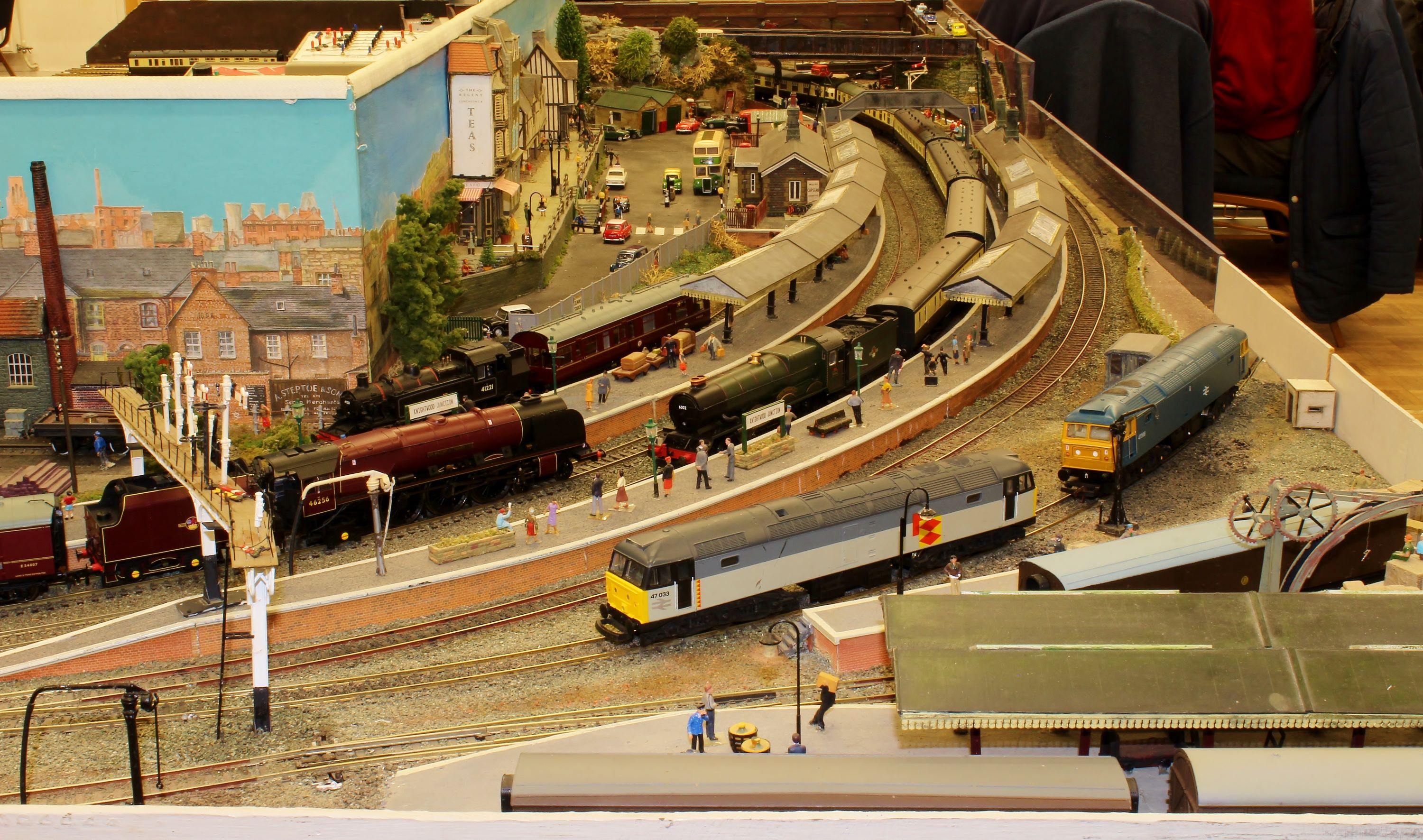
The main station of Knightwood Junction consists of a total of four platforms. Platforms 1 & 2 are on the main Up and Down lines. Platform 3 is on a loop off the Up Main line which also connects to a third-rail branch line. Platform 4 is the terminus of the branch that climbs away along the entire length of the layout, crossing a bridge over the main lines, to serve the small station at Knightwood providing a connection on to the main line.
There are long passing loops on both the Up and Down main lines that run for the majority of the length of the layout. The goods yard on the Down Main side is accessible from both directions. The parcels department, consisting of three platforms, is accessible only from the Up Main line.
Updates (In Progress and Future)
- Updating of points control panels to provide feedback of the current status of points when operated. Part of this has already been completed in the fiddle yard where inexpensive WiFi devices have allowed the use of PECO accessory switches and LED indicators to show the position of points furthest away from the operator.
- Replacement of the original deteriorating 'Sundela' fibre-board surface in the main fiddle yard with more durable marine plywood.
- A change from semaphore to colour light signals is slowly taking place. This uses the same WiFi devices that have been used for the fiddle-yard points indicators, with the addition of in-track detectors to allow the signals to be automatically triggered by passing trains.
Knightwood Canal
Knightwood Canal is a brilliantly detailed end-to-end OO layout that measures 10' x 3' overall. It's an industrial scene with a five-road engine shed and a 70' turntable. If all that is not enough, the layout can be operated in conjunction with Knightwood Junction, although this major task is not carried out very often. The photo below shows Knightwood Canal at the end of Knightwood Junction.
When Knightwood Junction and Knightwood Canal are run together, fourteen-coach trains – including sleepers – are seen as well as the usual nine or ten-coach formations. And of course, goods trains are shunting and passing through. Express train engine changes take place in the fiddle yard.
On both of these impressive layouts, the stock is mainly proprietary models, but some kit-built and modified locos are presented. And for some variety, locos from other regions pass through as cross-country trains or specials.
Milford on Sea
It's good to have a New Forest area layout that depicts a local railway, even if it is imaginary. It is true that Milford on Sea has never had a Station, but there were schemes put forward in the late 19th and early 20th century to link Milford with the LSWR main line to provide a direct alternative to the Horse Bus from Lymington Town station. There was even a suggestion that the line could go beyond Milford in a tunnel under the Solent to the Isle of Wight - quite fanciful as the Solent is deep and the gradients would have been very severe.

These plans were all part of a grandiose scheme to turn Milford (as it had been known since before the Doomsday Book) into Milford on Sea, a resort to rival, even surpass, Eastbourne. Some of the scheme actually happened: a number of hotels were built on the cliff top together with some grand houses for the wealthy. Most of these have long since been bulldozed and replaced with blocks of apartments. One does remain, Westover House, now the Beach House pub. This has a railway link of sorts as it was built in 1897 for Alexander Siemens the German industrialist and founder of the electrical engineering firm long associated with railways.

This terminus layout depicts what might have been if the railway had actually arrived - it would have probably been a branch line very much like the Swanage or Lymington Branches - offering some direct services to Waterloo and some connections to fast trains to and from Bournemouth and Waterloo. It would have received the third rail and electric trains in the early 1960s
Here the line survived to be part of the Southern Region of British Railways and is depicted in this layout in the 1960s, with passenger, freight and parcels traffic operated by steam, green diesel and electric trains. On some days, we can even imagine it lasted long enough to see blue and grey stock and even Network South East stock. The layout is a OO terminus station with a fiddle yard to the right and even has third rail. As the photo shows, Milford on Sea would have been a very busy place.
But wouldn't it have been great to get a train from Waterloo, travel down to Brockenhurst, onto the branch and stopping at Milford on Sea and then into the tunnel off to the Isle of Wight....
Penny Lane
Model railways don't always have to be about finely detailed stations, complex control systems, and extensive scenery. Sometimes they can be built just for the fun of it, having a theme that both amuses and impresses. Penny Lane is just such a member's layout: starting out as an experiment and then morphing into a brilliantly entertaining layout.
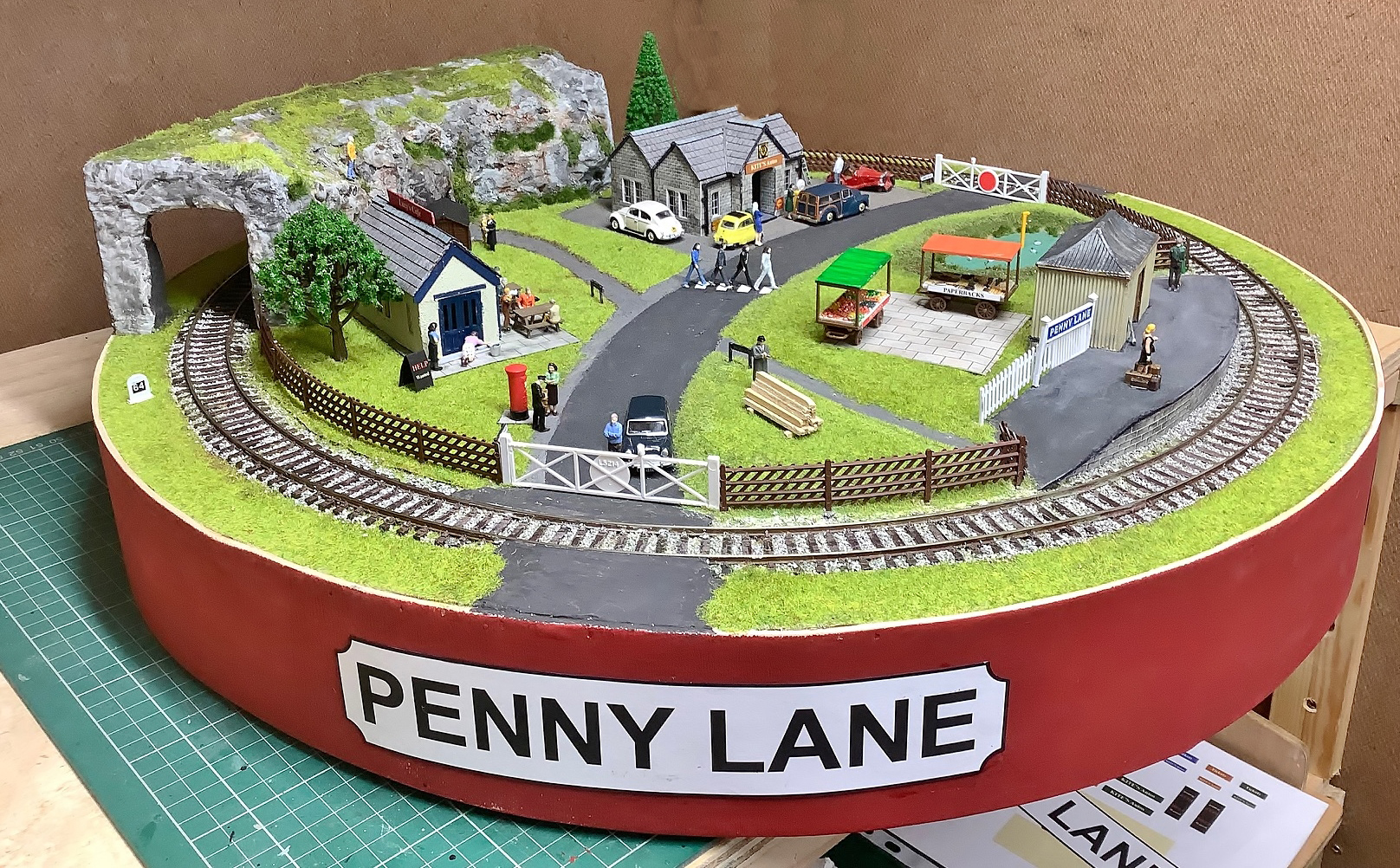
At only 23.5 inches in diameter, this layout/diorama started life as an experiment to see how long an OO gauge loco could run on a standard 9-volt battery, as typically used in smoke alarms and radios. The result was astonishing: the small Peckett tank loco ran for over ten hours, making it a handy option for a portable layout that doesn’t require mains power.

A small halt named Penny Lane was originally planned, but then the idea of using features based on The Beatles group became much more interesting. Several groups of figures were added to represent Beatles songs, such as Mr. Postman, which was just the start. Then a further sixteen figures and features followed. Building a small layout like this requires careful planning to ensure everything is visually balanced, without any one particular element dominating the scene.
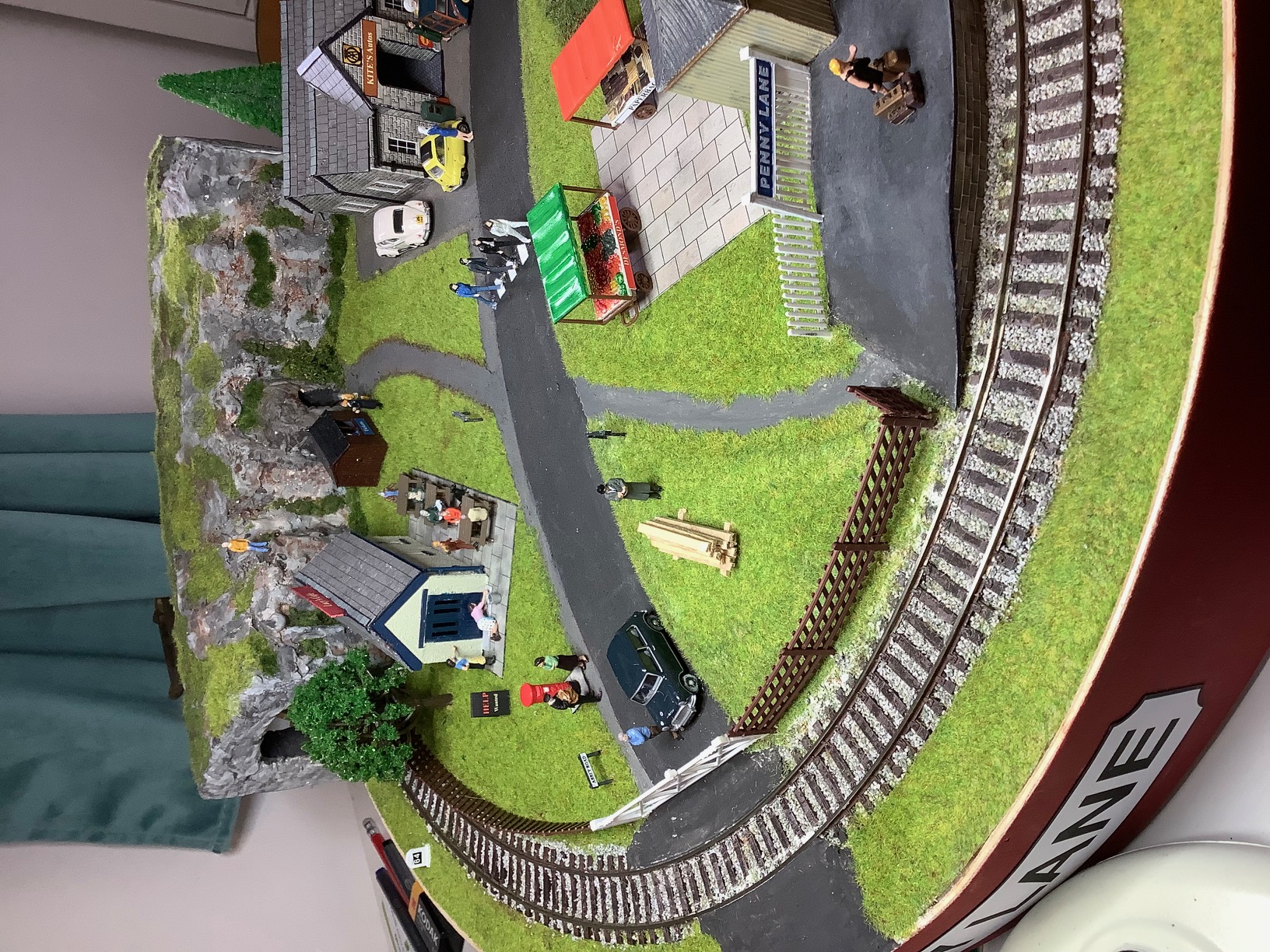
The layout has been a great success at our open days—not only for those who remember The Beatles songs but also for younger visitors who enjoy the challenge of spotting different themed features hidden within the layout.
Albany
The station on this layout is a scratch built representation of Arley station on the Severn Valley Railway. The layout is N gauge, 5' x 2'6" dimensions and a continuous double track formation. It is always satisfying if a layout can be modelled on a real location.
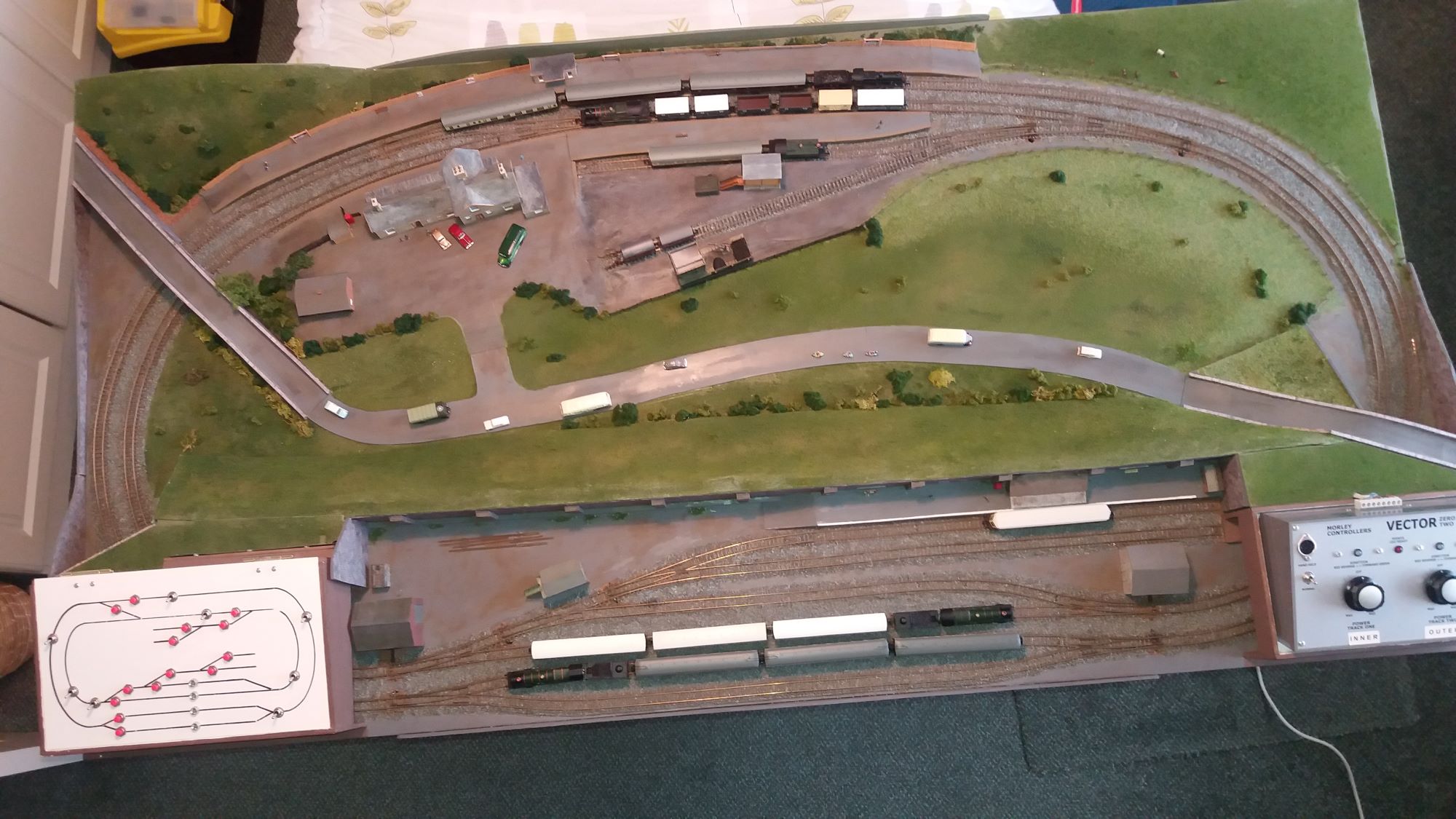
There is a four lane fiddle yard, but why should a fiddle yard be plain track work? On Albany the fiddle yard is a scenic feature with a terminus station shielded from the main layout by a hill.
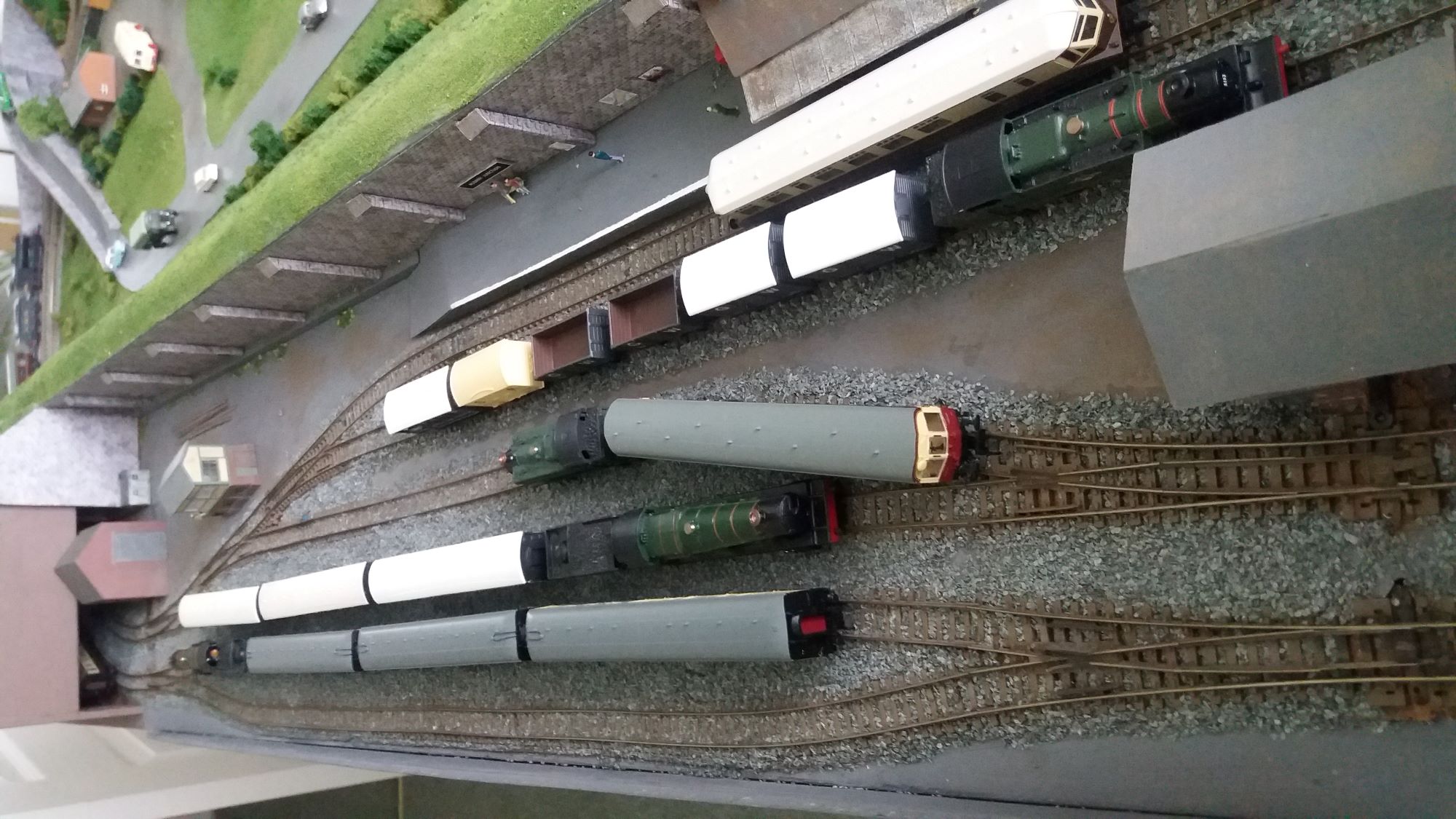
The station building based on the Arley station building.
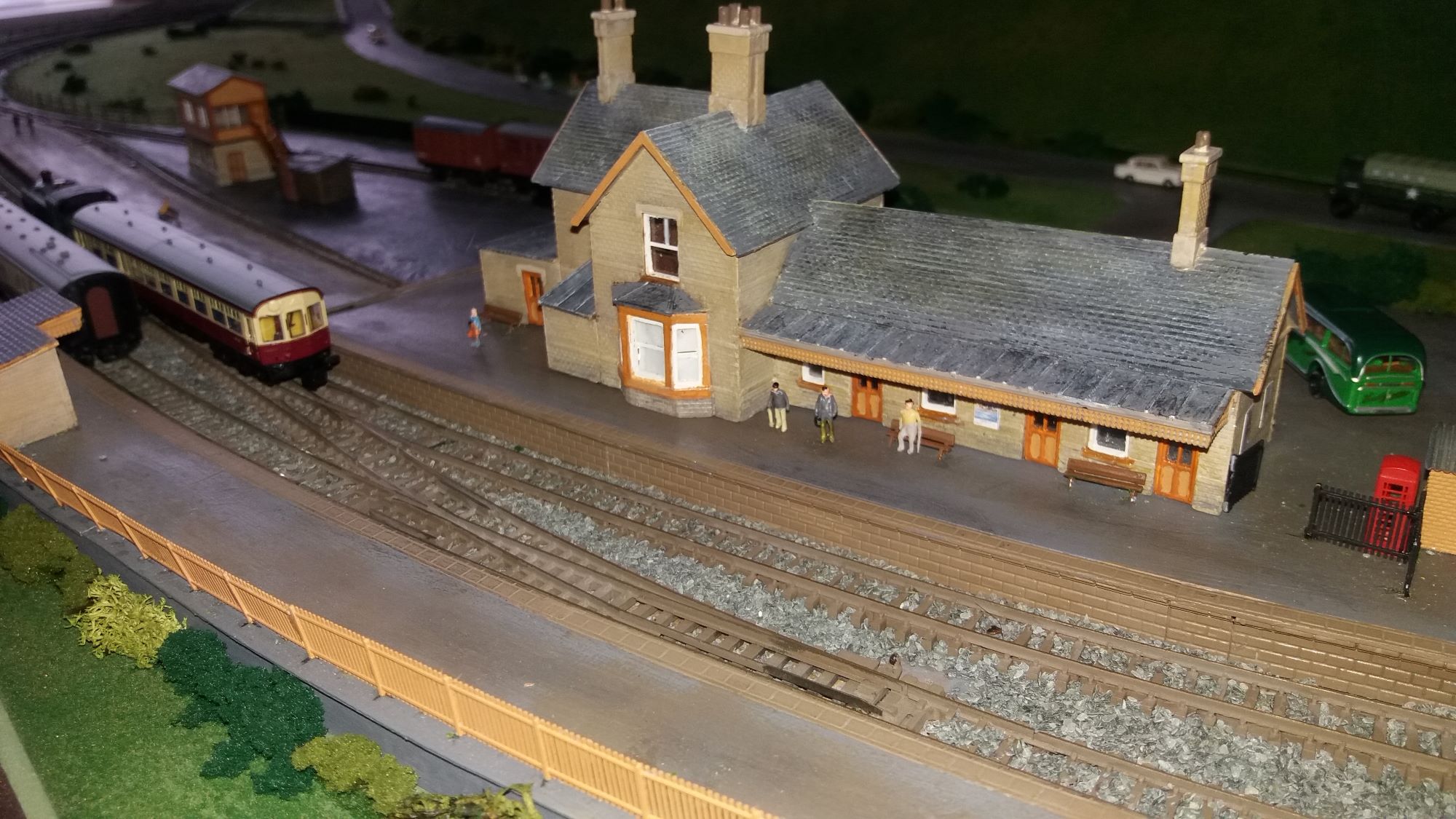
The analogue control panel is an integral part of the layout with a separate detachable Morley controller.
Ipleigh Castle
At the NFMRS we like small layouts as much as the larger layouts. They are simple to build and easy to transport, can still have lots of detail and are easy to operate. The size of a layout is not the main criteria for a satisfying build and providing entertainment.
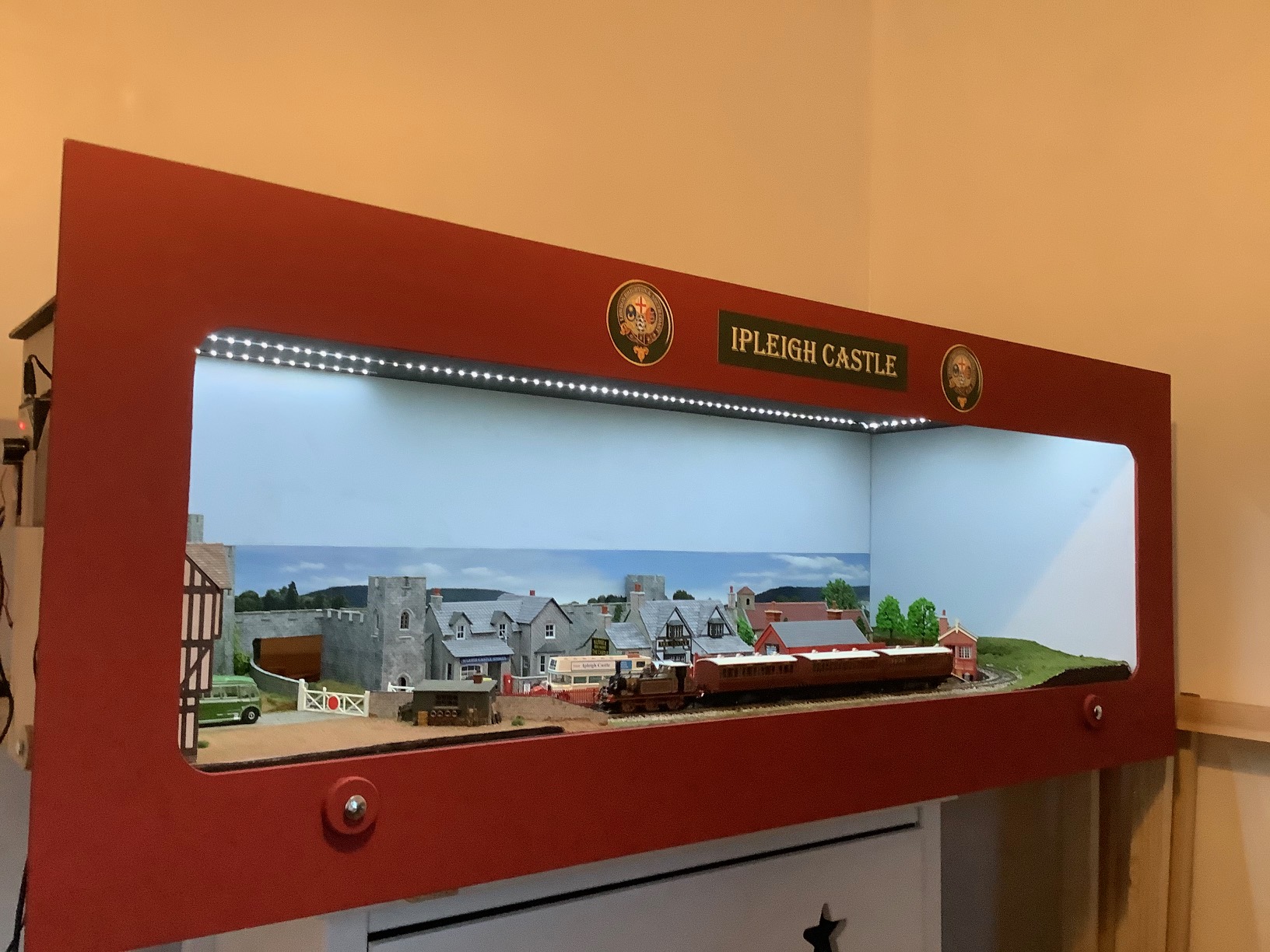
Ipleigh Castle (a fictional name of a place is Sussex) is such a layout. The layout board size is 4' x 2' with a single continuous 00 scale oval with a very small radius, something that books and magazines say cannot be done, but here is proof that it can be achieved. Those wishing to build a layout, but have space issues, please note. A stand is provided for viewing at eye level. The layout has dimmable lighting which allows the layout to go from daytime to dusk, and with all of the buildings being lit, it creates a good atmosphere for the viewers.
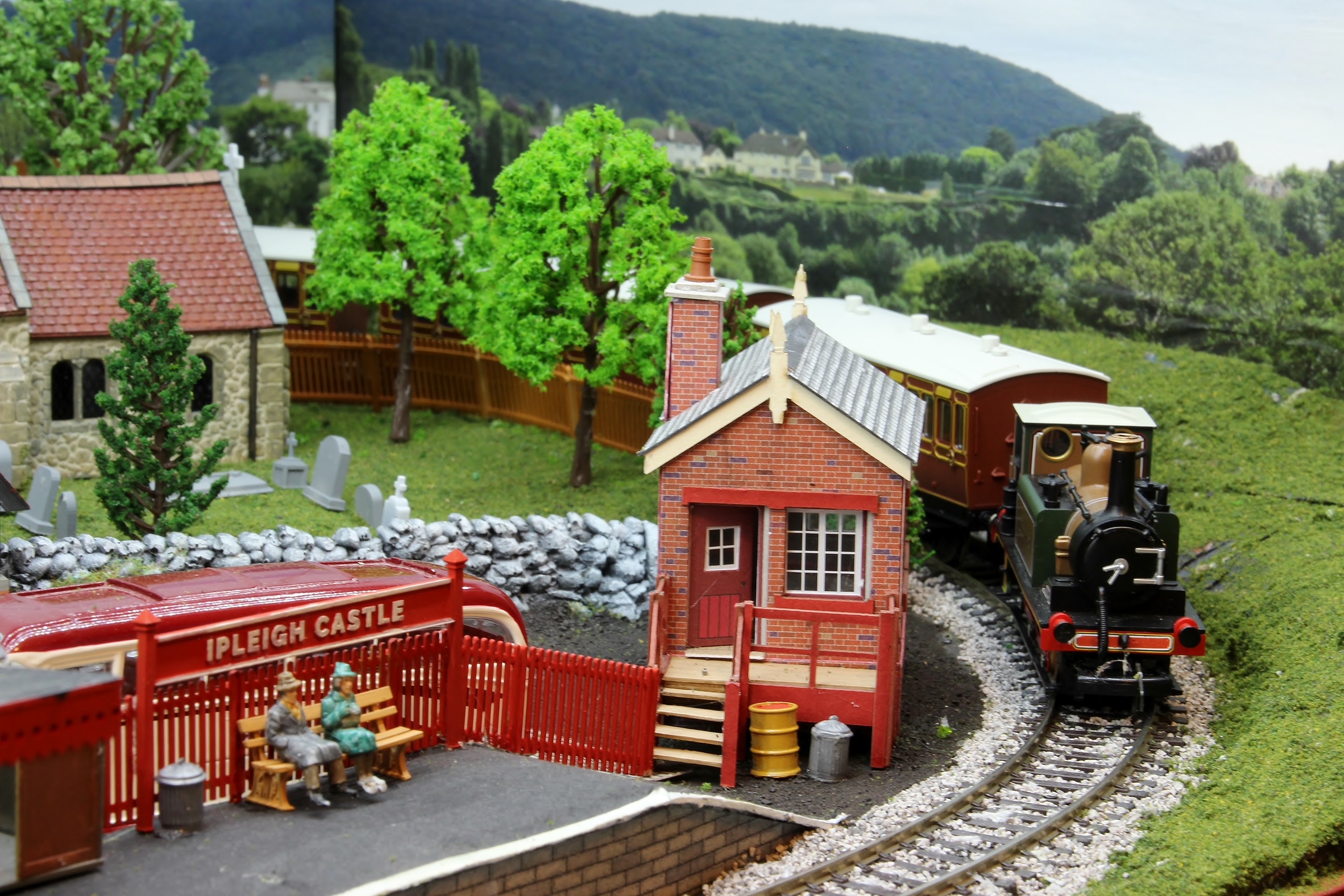
The photos show a Hornby 4 wheel LBSCR coaching stock which the operator finds very satisfactory. And the coaches have lights. No words here to describe the various buildings and structures: just take a long look at the photos.
Freshwater
This N gauge terminus layout is another based on a real location, this time on the Isle of Wight.
But first let us remind ourselves of the interesting history of railways on the Isle of Wight.
Freshwater was the last station on the western end of the Isle of Wight. Construction was started by the Freshwater, Yarmouth & Newport Railway in 1886 and the 12-mile line from Newport was opened to passenger traffic in July 1889.
The main intermediate stations were at Carisbrooke, Calbourne, Ningwood, and Yarmouth.
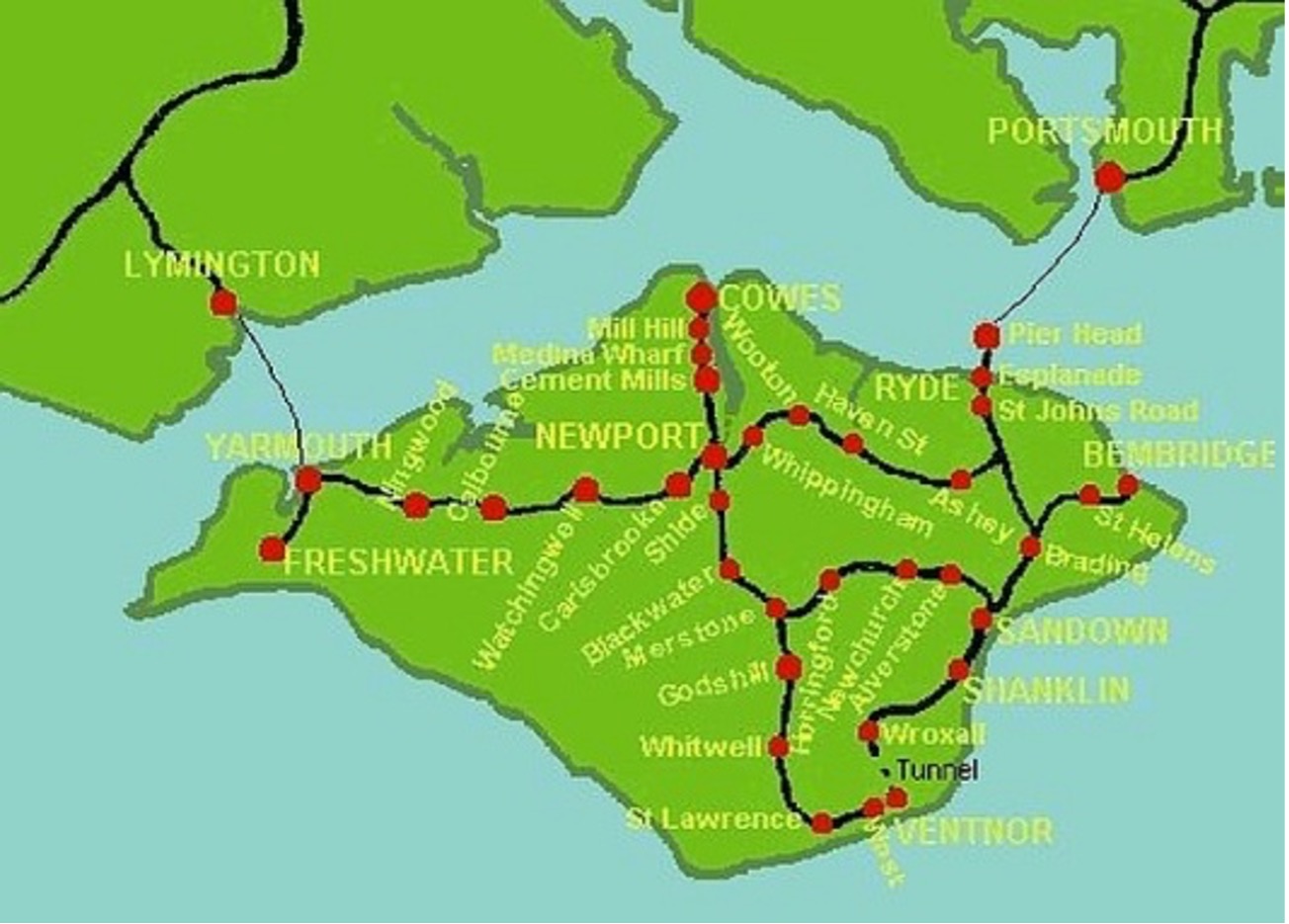
(Map reproduced by kind permission of Southern Railway email Group)
The main traffic was coal and agricultural produce with passenger numbers steadily increasing due to more of the population from the mainland taking holidays 'abroad'. There was even a through train from Ventnor called “The Tourist” which allowed travellers to go on to Alum Bay by coach for the coloured sands.
The platform had to be extended twice – hence the different heights and type of construction as faithfully depicted on this layout.
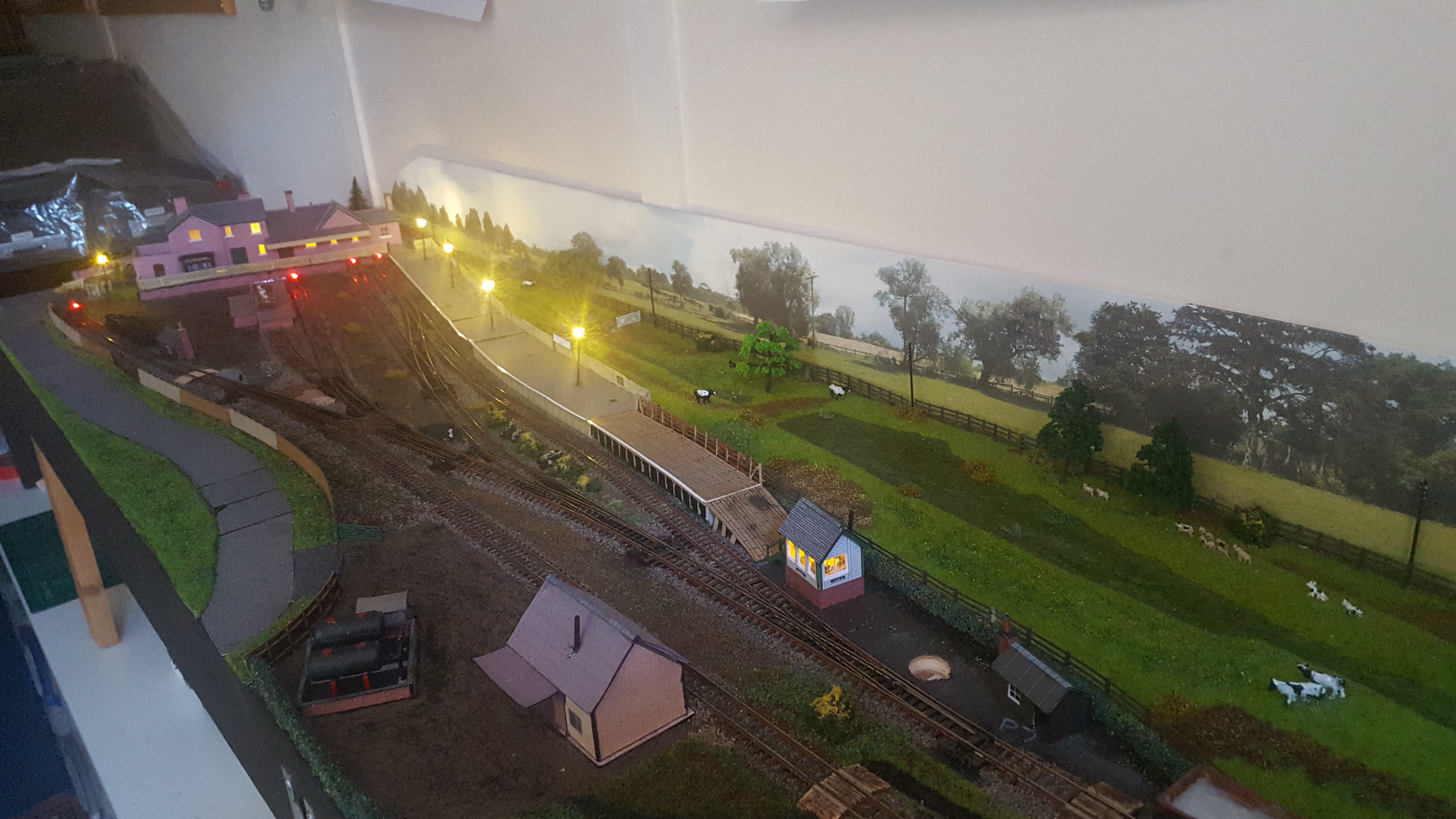
The station and buildings are fitted with LEDs.
The Freshwater, Yarmouth Newport branch was declared bankrupt in 1923 and the Southern Railway took over in 1927.
Over the years, there were various changes to the station track plan, the main one being in 1927 when the crossover, engine shed, siding and signal box were removed.
The line had mixed fortunes and eventually closed on 20th September 1953.
The layout is based on a mixture of 'before' and 'after' 1927 features which allows for 'modellers licence' to replicate the interesting features on the railway.
The layout is 8ft. x 18” and operates under DCC control. There is a working signal and mainly Terrier locomotives with a couple of 02’s. The variety of wagons cater for the range of goods carried by the Island railways during this period.
Some of the original platform is still in use – as a storage area in the adjoining garden centre. Sad to see so many old railways meet this fate.
Watchumgobye
During 2024 the club has continued the construction of a new large 00 gauge layout which has the amusing name ‘Wotchumgobye’ and was first exhibited at our 2022 Spring exhibition. The layout is 16’ x 11’ overall size in the form of a U with a continuous track. With this format the actual length the trains travel to complete one circuit is considerable.
The model era is 1955 to 1965 so steam and diesel hauled trains can be run. The layout requires a minimum of two operators but three is ideal.
And further interest is provided by a 009 narrow gauge line at a higher level. The story goes that the line originally served a quarry and took its wares to the harbour but fell into disrepair and was brought by a group of volunteers and is now a tourist attraction. The 009 line runs independently from the 00 line.
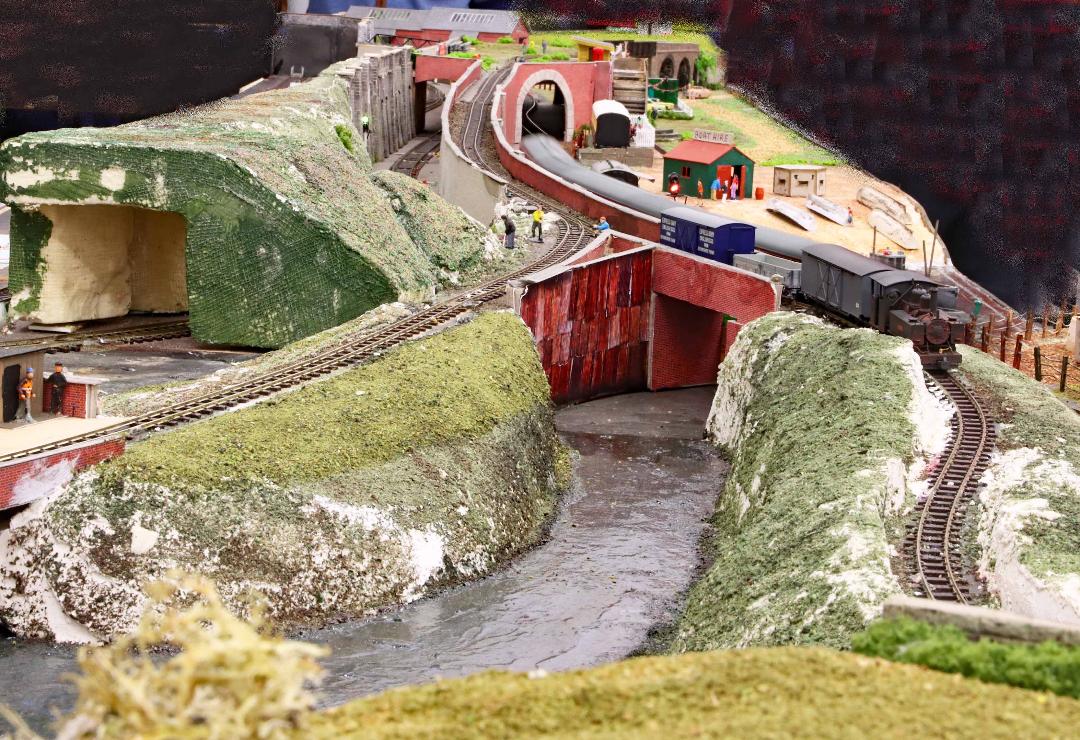
The 009 line runs at higher level than the 00 line.
The 00 lines are DCC controlled and the 009 lines analogue controlled and both have many clever features such as automated signals which in conjunction with track isolations stop and start trains. All of this on the 00 lines enables up to three trains to run simultaneously on each track so each train becomes an endless tail chaser!
Scenic features include a harbour,
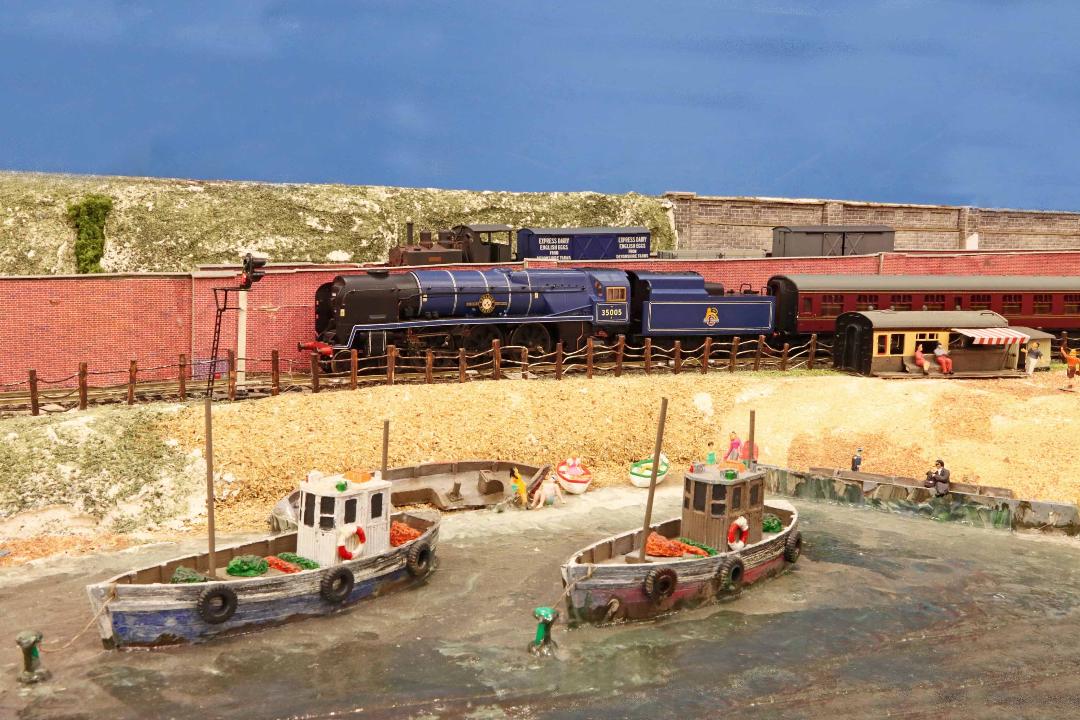
… a beach,
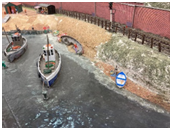
… a busy station with large signal box and includes sidings acting as train storage,
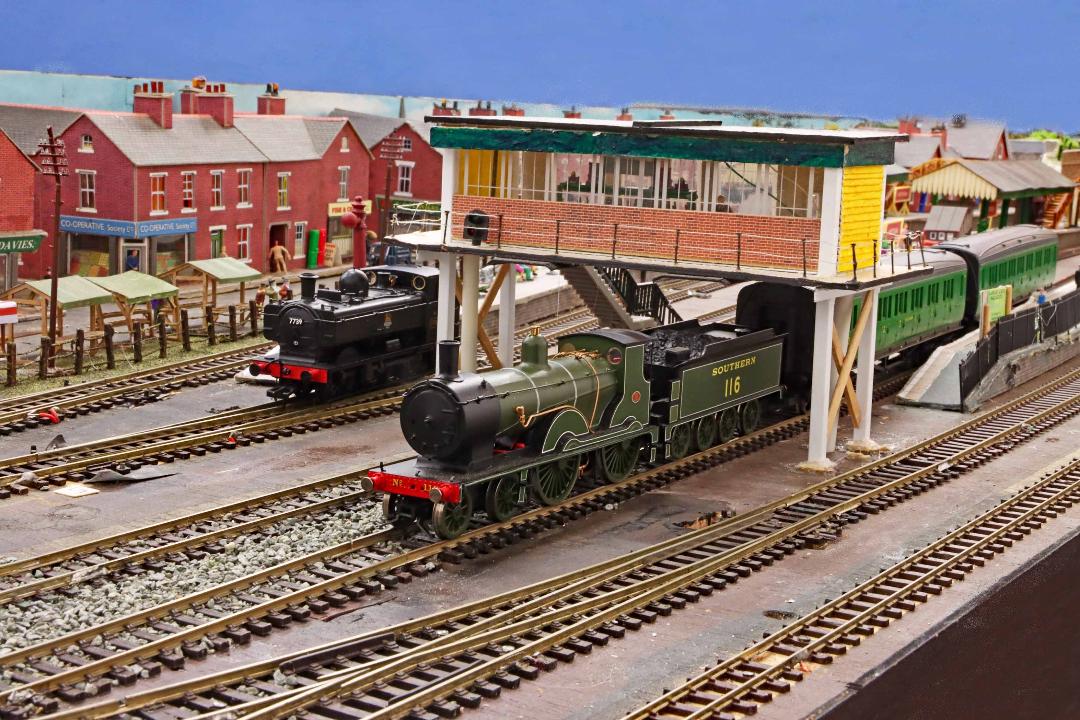
… a pub with trackside cottages,
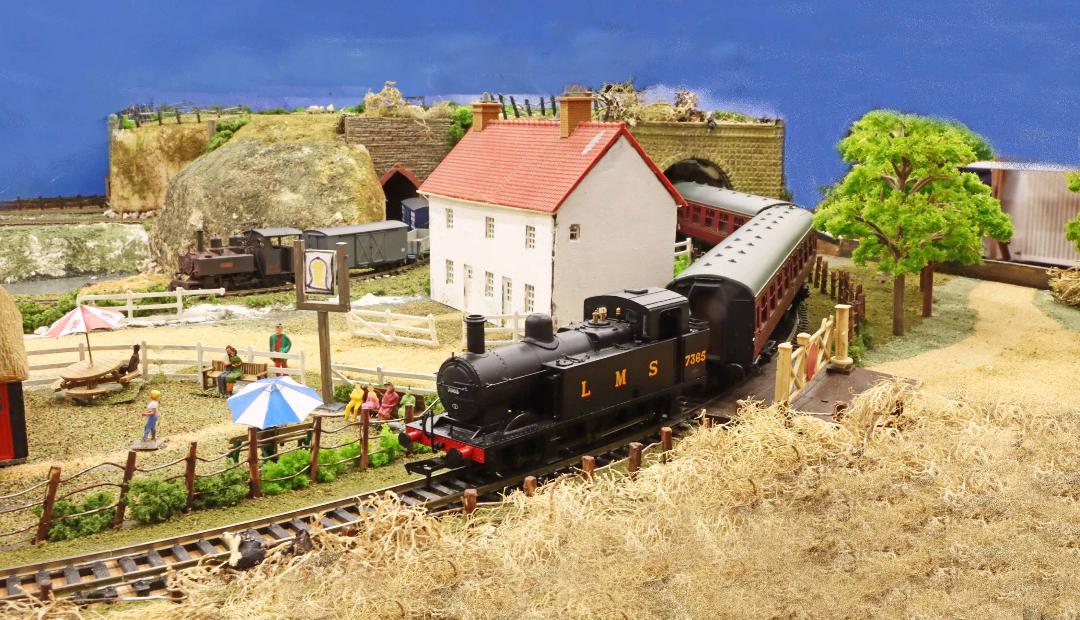
… and embankments, cuttings, tunnels and bridges.
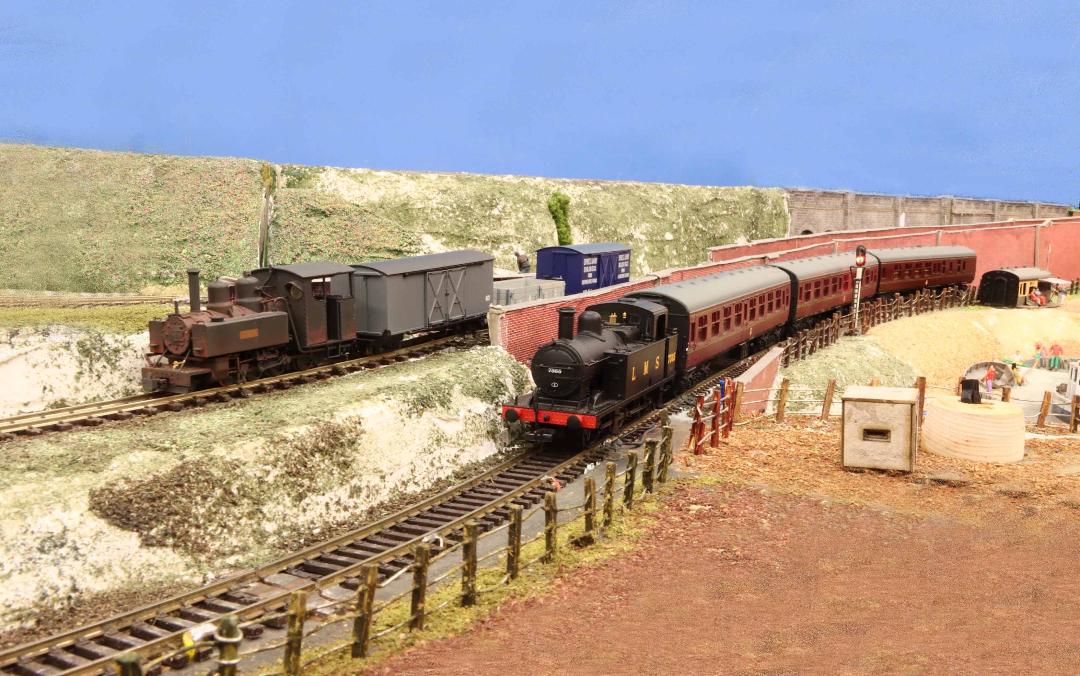
There is still work to do on Wotchumgobye, mostly on scenic details and refining the control system. Will be ready for the 2025 spring exhibition.
Future Layouts
Work continues on developing our existing layouts and constructing new.
A modular N gauge layout is under construction that will have four continuous tracks each individually operated. We intend to have several interesting scenic features that are still to be decided.
An end-to-end 00 gauge layout is also under construction with complex sidings and terminal station.
We hope to showcase both of these new layouts at our November Open Day.